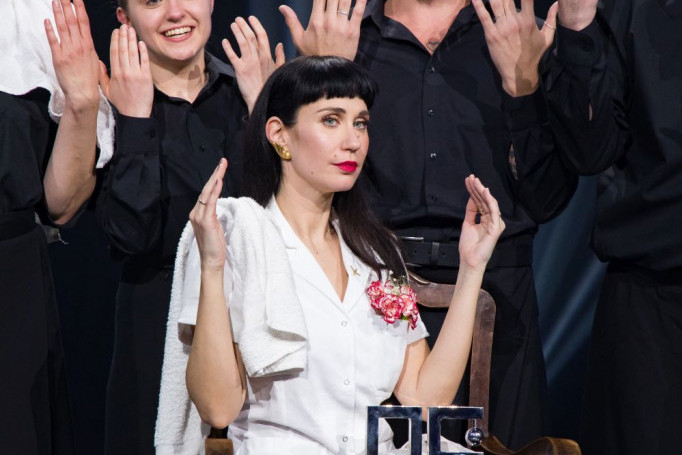Since Konstrakta won the opportunity to represent Serbia at Turin, her song ‘In Corpore Sano’ (translated from Latin meaning ‘A healthy body’) has certainly set tongues wagging. Whether you love it or hate it, Eurofans are fascinated by the song’s complex exploration of beauty standards, mental health and the Serbian healthcare system. However, will ‘In Corpore Sano’ take Turin by storm or is it likely to get lost in translation?
‘In Corpore Sano’ – A Deep Dive
Picture the scene: you’re a Eurofan settling down to watch Pesma za Evroviziju 2022, Serbia’s national selection contest for Eurovision. Amongst the rock, pop girlies and Balkan ballads a woman appears, her face and voice deadpan as she stares down the barrel of the lens, wearing a glaring white outfit and washing her hands. Your first thought might be “What on earth is this?” Especially as the only words you recognise in the song (if you don’t speak Serbian of course) are “Meghan Markle”.
This was the experience of many non-Serbian Eurofans watching the contest. However, that intrigue resulted in multiple breakdowns of the song and performance online, revealing a song with far more complexity than your token ‘weird Eurovision entry’.
Take the infamous opening line as an example: “What is the secret behind Meghan Markle’s healthy hair?” This line could be lifted from any magazine but Konstrakta goes on to say “One’s skin and hair reveal everything clearly…Stain’s around lips might mean you have an enlarged spleen/An enlarged spleen is not good, not pretty.” Here, Konstrakta holds a mirror up to society, reflecting the way we associate physical beauty with good physical health.
Something that will undoubtedly have resonated with Serbian viewers is the song’s third verse, where Konstrakta explains that she doesn’t have health insurance as the Serbian healthcare system does not provide free healthcare to artists. At this point, the song takes on a marginally more frantic tone as it builds to its climax: “A sick mind in a healthy body/A sad soul in a healthy body/A desperate mind in a healthy body/A frightened mind in a healthy body/So what do we do now?” Paired with Konstrakta’s handwashing on stage, the message becomes clear: if we are so focused on taking care of our physical health (particularly if a lack of health insurance necessitates that) what happens when it is our minds that become sick? Given the impact the COVID-19 pandemic has had on our mental health, even if we have been lucky to emerge physically unscathed, this is an issue that many of us are all too familiar with.
‘In Corpore Sano’ has drawn comparison to the works of fellow Serbian performance artist Marina Abramovic and it’s easy to see why, particularly Abramovic’s 1975 performance piece ‘Art Must Be Beautiful, Artist Must Be Beautiful’. In this piece, Abramovic brushes her hair with mounting aggression whilst repeating the phrase “Art must be beautiful, artist must be beautiful”, wincing in pain as she does so. Speaking about the piece retrospectively, Abramovic said it was “really about this idea of art that it should be beautiful, that the painting should fit the colours of the carpet in the living room, which I think was so wrong because it’s my point of view that art has to be disturbing.” Abramovic achieved this, taking an act typically associated with beauty and making it increasingly uncomfortable to watch. Similarly, Konstrakta takes an action associated with health – handwashing – and uses it to represent an increasingly unhealthy state of mind.

Will It Be Alright on the Night?
Undoubtedly ‘In Corpore Sano’ is a thought-provoking piece of performance art that has left a lasting impression on those who have watched it. It is therefore perhaps unsurprising that it stormed both the jury and televotes of Pesma za Evroviziju 2022. However, this does not necessarily mean Konstrakta’s success will translate to the stage at Turin.
The grand final of Pesma za Evroviziju 2022 attracted approximately 1.5 million viewers on 5th March. By contrast, last year’s Eurovision Song Contest attracted a whopping 183 million viewers across its two semi-finals and grand final. Therefore, Konstrakta has a lot more fans to impress and little time to do it in (she performs in the second semi-final on 12th May). The majority of fans not only won’t speak Serbian but also watch Eurovision casually, as a social occasion with friends and family. While ‘In Corpore Sano’ might pique the interests of viewers in May, will they take the time to appreciate its complexity or simply see it as a strange song with the words “Meghan Markle” in it (the only lyrics most viewers are likely to understand unless they speak Latin)? If part of the song’s appeal is its complexity and open interpretation, is it likely to go over the heads of an audience consisting mostly of casual viewers who might have already had a few alcoholic beverages?
Does It Really Matter?
So ‘In Corpore Sano’ might get lost in translation. Is that such a big deal? In 2017, Francesco Gabbani represented Italy with ‘Occidentali’s Karma’, a song that criticised the materialism of Westerners and their westernisation of Eastern cultures. Laden with references to Karl Marx, William Shakespeare’s ‘Hamlet’ and ‘The Naked Ape’ by Desmond Morris, it’s safe to say that a lot of the song’s lyrics went over the heads of non-Italian casual fans of the contest, who chuckled over a man in a gorilla costume instead. However, this doesn’t mean the song wasn’t successful: it placed 6th overall and received points from many of the participating countries.

If ‘In Corpore Sano’ can capture the attention of viewers it could perform well in ESC 2022. Certainly, it has managed to do this so far. As well as receiving praise from a number of journalists, the song also reached number one on YouTube trending charts across all former Yugoslav republics as well as in Austria and Switzerland. A video of Konstrakta’s performance in the first semi-final has amassed 11 million views on YouTube to date and the lyrics also reached number two on the trending charts of Genius, a website which allows users to analyse song lyrics. The song even birthed a TikTok trend, where users replicated its choreography during the chorus. Even if the message of ‘In Corpore Sano’ isn’t understood by all, this isn’t necessarily going to stop it performing well at ESC.
There are also steps artists can take to ensure their songs’ messages are heard: the video for ‘In Corpore Sano’ on ESC’s YouTube channel has subtitles and it has been suggested these could be incorporated into Konstrakta’s performance at Turin. This was a strategy employed by Ermal Mata and Fabrizio Moro in Eurovision 2018 with their song ‘Non mi avete fatto niente’ (‘You haven’t done anything to me’). During their performance, subtitles for the lyrics were imposed onto the screen in a range of languages, ensuring the song’s messages about war and terrorism could be understood by all. It placed 5th overall and was even nominated for the Voices for Freedom Award for the best song with a social message! Could a similar strategy, adopted by Konstrakta, ensure her success both in and out of the competition?

Final Thoughts
We ultimately won’t know if Konstrakta has been successful in getting her message across until she performs in the semi-final and/or grand final in May. Either way, it’s always interesting when a country sends something a bit different to Eurovision.
Do you think ‘In Corpore Sano’ will succeed at Turin or do you think people won’t get it? Do you like complex and artistic songs at Eurovision or do you think it’s best to keep things simple? Let us know in the comments!





Pingback: Ко је српски кандидат за Евровизију 2022? Упознајте Сингер Цонструцта
Pingback: 🇷🇸All about Konstrakta: Serbia’s 2022 artist preview – Phoenix
Pingback: Editorial: Can ‘Who the hell is Edgar?’ teach us about the realities of being a female songwriter? – Phoenix